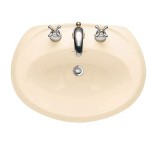How Do You Measure for a Bathroom Sink?
Choosing the right bathroom sink involves more than just aesthetics. Accurate measurements are crucial for ensuring a proper fit and functionality within the bathroom vanity. This article will guide you through the essential steps of measuring for a bathroom sink, covering various sink types and the specific dimensions required.
Measuring for a Drop-in Sink
Drop-in sinks, also known as self-rimming sinks, are installed into a pre-cut hole in the countertop. Measuring for these sinks requires focusing on the countertop opening and the sink's rim.
- Measure the existing countertop cutout: If replacing an existing drop-in sink, measure the length and width of the cutout in the countertop. This provides the maximum dimensions for the new sink.
- Measure the sink's outside rim: For a new sink, measure the outside length and width of the sink's rim. This determines the minimum size of the countertop cutout.
- Consider the reveal: The reveal is the portion of the countertop visible around the sink's rim. Factor in the desired reveal when determining the cutout size. A larger reveal means a smaller sink can be used.
- Check the sink's depth: Measure the sink's depth from the rim to the bottom. Ensure it provides adequate space within the vanity cabinet.
Measuring for an Undermount Sink
Undermount sinks are mounted beneath the countertop, providing a seamless and elegant look. Measurements for these sinks focus on the cabinet space and the countertop overhang.
- Measure the cabinet opening: Measure the length, width, and depth of the cabinet opening where the sink will be installed. This determines the maximum size of the sink basin.
- Account for countertop overhang: Consider the countertop overhang when measuring the sink's dimensions. The sink should not interfere with the overhang or any cabinet framing.
- Check the sink's depth: Ensure the sink's depth, measured from the rim to the bottom, provides enough space within the vanity and does not interfere with plumbing.
- Measure the drain placement: Locate the drain placement on the sink and ensure it aligns with the existing plumbing in the cabinet.
Measuring for a Vessel Sink
Vessel sinks sit on top of the countertop, making a bold design statement. Measurements for these sinks primarily concern the countertop space and faucet height.
- Measure the countertop space: Measure the available countertop space where the sink will be placed. This determines the maximum diameter or dimensions of the vessel sink.
- Consider the faucet height: Vessel sinks require specific faucet types, often tall vessel faucets or wall-mounted faucets. Measure the distance from the countertop to the desired faucet height.
- Account for drain placement: Ensure the drain placement on the sink aligns with the existing plumbing or plan for necessary adjustments.
Measuring for a Pedestal Sink
Pedestal sinks offer a classic and space-saving solution. Measurements for these sinks focus on the overall dimensions and the available floor space.
- Measure the available floor space: Measure the length and width of the area where the pedestal sink will be installed. This determines the maximum dimensions of the sink and pedestal base.
- Check the sink's height: Measure the height of the sink and pedestal to ensure comfortable usage.
- Account for wall clearance: Measure the distance from the wall to the front edge of the sink to ensure adequate clearance.
- Measure the drain placement: Ensure the drain placement on the sink aligns with the existing plumbing.
Measuring for a Wall-Mounted Sink
Wall-mounted sinks provide a modern and minimalist aesthetic while maximizing floor space. Measurements for these sinks are crucial for proper installation and accessibility.
- Measure the wall space: Measure the available wall space where the sink will be mounted. This determines the maximum dimensions of the sink.
- Determine the mounting height: Consider the desired height for comfortable usage, typically around 30-36 inches from the floor to the top of the sink.
- Check wall strength: Ensure the wall is strong enough to support the weight of the sink and its contents. Consult a professional if necessary.
- Account for drain placement: Ensure the drain placement on the sink aligns with the existing plumbing or plan for necessary adjustments within the wall.
General Considerations When Measuring
Regardless of the sink type, certain general considerations apply to all measurements:
- Accuracy is key: Use a tape measure and record measurements accurately to the nearest fraction of an inch. Double-check measurements to avoid errors.
- Consult manufacturer specifications: Refer to the manufacturer's specifications for the specific sink model. These specifications provide detailed dimensions and installation requirements.
- Consider plumbing and fixture placement: Take into account the location of existing plumbing, including water supply lines and drain pipes. Also consider the placement of faucets and other bathroom fixtures.
By following these measurement guidelines and carefully considering the specific requirements of each sink type, one can select a bathroom sink that fits perfectly within the bathroom space and enhances both functionality and aesthetics.
How To Measure For A Bathroom Basin Or Sink Victoriaplum Com

How To Measure A Basin

How To Choose The Right Vanity For Your Bathroom Riverbend Home

Standard Bathroom Sink Dimensions With Photos Upgradedhome Com

How To Measure A Bathroom Sink Size Lavatory For Replacement

Bathroom Layout Measurement Advice Victoriaplum Com More

How To Measure A Bathroom Sink Size Lavatory For Replacement

What S The Standard Depth Of A Bathroom Vanity

Standard Bathroom Sink Dimensions With Photos Upgradedhome Com

How To Measure For A Bathroom Vanity The Home Depot
Related Posts







